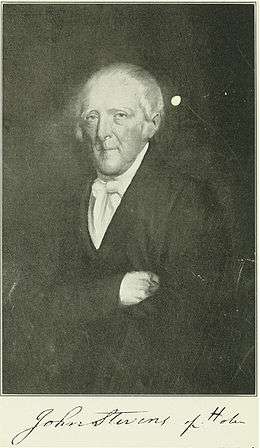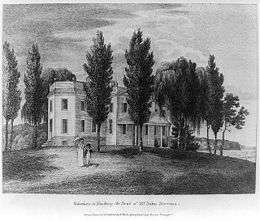John Stevens (inventor)


Col. John Stevens, III (June 26, 1749 – March 6, 1838) was an American lawyer, engineer, and inventor who constructed the first U.S. steam locomotive, first steam-powered ferry, and first U.S. commercial ferry service from his estate in Hoboken. He was influential in the creation of U.S. patent law.
Life and career
Stevens was born June 26, 1749, in New York City, New York,[1] the son of John Stevens, a prominent state politician who served as a delegate to the Continental Congress, and Elizabeth Alexander, daughter of New York lawyer and statesman James Alexander. His sister, Mary Stevens (d. 1814), married Robert R. Livingston, the first Chancellor of the State of New York.
He graduated King's College (which became Columbia University) in May 1768.
At age 27 he was appointed a Captain in Washington's army, and was afterwards treasurer of New Jersey, and bought at public auction from the state of New Jersey land which had been confiscated from a Tory landowner. The land, described as "William Bayard's farm at Hoebuck" comprised approximately what is now the city of Hoboken. Stevens built his estate at Castle Point, on land that would later become the site of Stevens Institute of Technology (bequeathed by his son Edwin Augustus Stevens).[2]
In 1802 he built a screw-driven steamboat, and in 1806 he built the Phoenix, a steamboat that ultimately sailed from Hoboken to Philadelphia in 1809, thereby becoming the first steamship to successfully navigate the open ocean.[3]
In October 1811, Stevens' ship the Juliana began operation as the first steam-powered ferry (service was between New York, New York, and Hoboken, New Jersey).[4] The first railroad charter in the U.S. was given to Stevens and others in 1815 for the New Jersey Railroad. He designed and built a steam locomotive capable of hauling several passenger cars at his estate in Hoboken, New Jersey in 1825.The invention of the steam engine helped begin the modern railroads and trains. He also helped develop United States patent law.
Family
On October 17, 1782, he married Rachel Cox, a descendant of the Langeveldts (Longfields) who originally settled New Brunswick, New Jersey.[5]
They had thirteen children:[5]
- John Cox Stevens (1785–1857), first commodore of the New York Yacht Club.
- Robert Livingston Stevens (1787–1856), applied the wave line to shipbuilding, and president of Camden and Amboy Railroad, the first railroad built in New Jersey.
- James Alexander Stevens (1790–1873)
- Richard Stevens (1792–1835)
- Francis Bowes Stevens (1793–1812)
- Edwin Augustus Stevens (1795–1868), founder of Stevens Institute of Technology.
- Elizabeth Juliana Stevens (1797–1821)
- Mary Stevens (1799–1825), first wife of Rear Admiral Joshua R. Sands
- Harriet Stevens (1801–1844), second wife of Joshua R. Sands
- Esther Bowes Stevens (1804-?)
- Catherine Sophia Van Cortlandt Stevens (1806-?)
Notes
- ↑ John Stevens,: An American Record by Archibald Douglas Turnbull
- ↑ "Hoboken, Castle Point", Historic Houses of New Jersey (1902).
- ↑ New Jersey, a Guide to Its Present and Past, 1939, steamboats p. 99.
- ↑ Free Public Library of Jersey City (1909). From canoe to tunnel
 . A. J. Doan. p. 7 [scan]
. A. J. Doan. p. 7 [scan]  .
. - 1 2 The Cox Family in America (1912), pp. 223-7.
References
- Iles, George (1912), Leading American Inventors, New York: Henry Holt and Company, pp. 3–28
External links
- John Stevens Collection, 1808 - 1881 Archives Center, National Museum of American History, Smithsonian Institution.
- The National Cyclopaedia of American Biography. John Stevens article, volume 11, page 21, published 1901 by John T. White,.
- Col. John Stevens, III at Find a Grave
- Rutger exhibitions